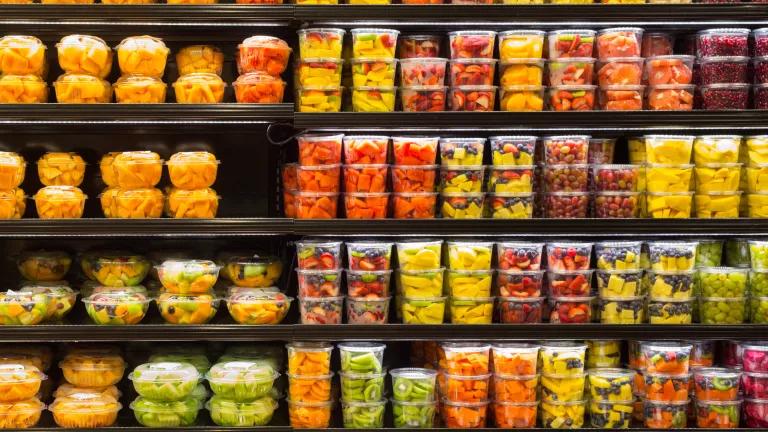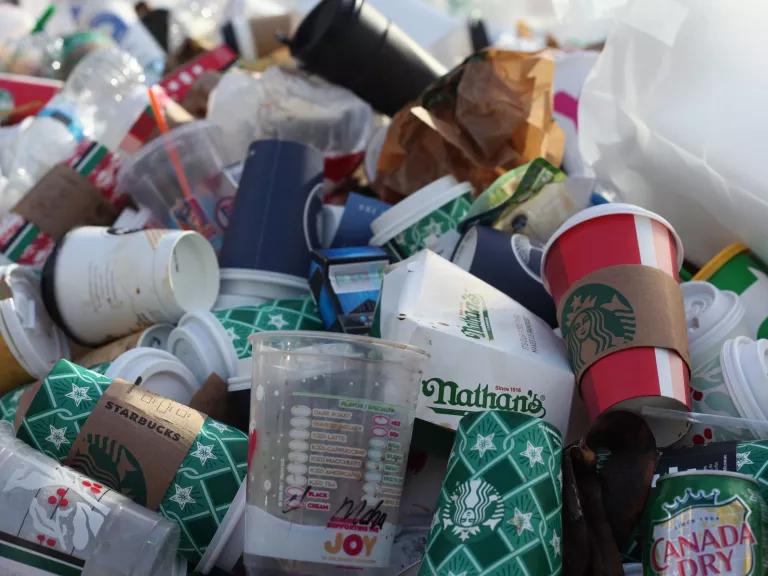Waste and Plastic Reduction Is Necessary to Protect Our Health
Why New York’s Waste Reduction and Recycling Infrastructure Act is a critical step forward.

This summer nearly 50 million people flocked to theaters to see Barbie live in her perfect plastic world, envisioning themselves in their own pink plastic house with a perfectly manicured plastic lawn. Sadly, our own plastic world isn’t so dissimilar: it is estimated 400 million metric tons of plastic are generated annually, polluting our cities, clogging our oceans, perpetuating our reliance on fossil fuels, and putting our health at risk. Approximately 36 percent of all plastic produced is used for packaging, the majority being single-use plastic products and containers for food and beverage. High levels of exposure to plastic pollution have been linked to everything from infertility to cancer in humans, with front-line communities being particularly impacted.
New York’s role in the global solid waste and plastic problem is not insignificant, with an average of 6.8 million tons of packaging waste produced each year in New York, constituting 40 percent of the total waste stream. Every year New York’s solid waste crisis continues to intensify, with municipal landfills nearing capacity, 17 percent of the State’s municipal solid waste exported out of state for disposal, and continued reliance on 11 incinerators across the state (the second highest number per state in the US). Despite calls for action from environmental advocates, municipalities, and waste management operators, the State has made too little progress in solving the dire solid waste and plastic crises.
Without a comprehensive response that is focused on front-end strategies to reduce waste and plastics, improve recycling infrastructure, and hold producers to account for packaging waste created, threats to our climate and public health will continue to compound.
The New York Waste Reduction and Recycling Infrastructure Act (S4246A/A5322A) would put New York on the much-needed path to addressing these crises by holding producers of packaging materials and products responsible, mandating strong waste and plastic reduction targets, improving municipal recycling programs, and reducing exposure to toxic chemicals. It is our best chance in years to advance the State’s solid waste hierarchy and give waste reduction and reuse the attention that the Legislature called for when it enacted the 1988 Solid Waste Management Act.

This bill has three crucial features:
Meaningful waste reduction targets
The legislation centers strong waste reduction targets and recognizes the often overlooked costs of plastic packaging. Unlike glass, steel, and aluminum, plastic is simply not designed to be recycled. Reduction targets will help achieve important environmental, economic, and social benefits, while relieving the pressure on municipal curbside recycling programs that struggle to keep up with the volume of waste – the majority of which is plastic containers and packaging. The bill recognizes a sharp decline in packaging waste is needed by calling for:
- 50 percent reduction of packaging materials within 12 years with incremental milestones.
- 75 percent recycling rate of the remaining packaging waste by 2050 also achieved incrementally, with separate criteria for non-plastic and plastic packaging, and
- Requiring packaging materials to be truly reusable or recyclable.
Ban Toxic additives and problem plastics
S4246A/A5322A also restricts some of the most toxic substances in packaging and addresses problematic plastics. In our latest fact sheet, The Worst of the Worst: High-Priority Plastic Materials, Chemical Additives, and Products to Phase Out, NRDC calls for the phase-out of plastic polymers, additives, and products that: pose significant hazards to human health and the environment; are difficult to recycle and/or interfere with mechanical recycling systems; or are just simply unnecessary (like many single-use plastic items). This legislation addresses many of these recommendations by prohibiting the most toxic substances from being used in packaging, including polyvinyl chloride (PVC), PFAS (“forever chemicals”), formaldehyde, bisphenols, toluene, and heavy metals. The bill also bans other problem plastics like pigmented plastics which are notoriously difficult to recycle. Toxic substances in food-contact packaging are particularly concerning as these substances can leach out of packaging into the food and beverages we consume and accumulate in our bodies, contributing to diabetes, heart disease, cancers, obesity, and infertility.
Promote improvements and investments in traditional recycling infrastructure, not chemical recycling
Finally, this bill promotes investment in traditional (mechanical) recycling infrastructure rather than so-called “chemical recycling,” a false solution which is being promoted by the fossil fuel and plastic industry. “Chemical recycling” is not actually recycling, will not contribute to a non-toxic circular economy, and has been shown to create hazardous air pollution and generate hazardous waste at industrial facilities that are often located in low-income communities of color.
Importantly, this legislation holds producers, rather than municipalities and taxpayers, responsible for a portion of the costs of end-of-life disposal of packaging waste. It includes a funding mechanism to ensure municipalities are reimbursed for their recycling, composting, and waste reduction operations. And it provides for the creation of an independent office of recycling inspector general within the Department to ensure implementation and enforcement of the statute.
While the Barbie movie provided great summer entertainment for millions providing thought-provoking commentary on feminism and the legacy of Barbie, it did not tell the story of the ramifications of the plastic façade on our fragile planet. Back here in the real-world, we need legislation like the New York Waste Reduction and Recycling Infrastructure Act to maximize waste reduction, especially plastic waste, reduce pollution and toxics exposure, and expand our municipal recycling infrastructure to better serve our communities.





